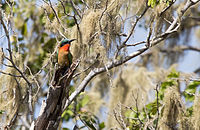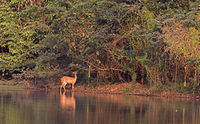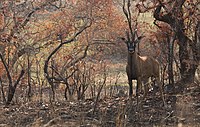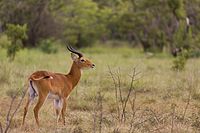User:ETF89/sandbox
| Comoé National Park | |
|---|---|
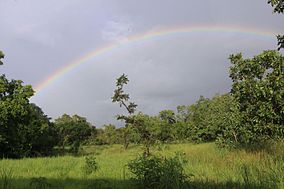 Comoé national park savannah with rainbow | |
| Location | Côte d'Ivoire |
| Coordinates | 9°06′N 3°42′W / 9.100°N 3.700°W |
| Area | 11,493 km² |
| Established | February 8, 1968 |
| Type | Natural |
| Criteria | ix, x |
| Designated | 1983 (7th session) |
| Reference no. | 227 |
| State Party | Côte d'Ivoire |
| Region | Africa |
| Endangered | 2003–present |
The Comoé National Park is a UNESCO World Heritage Site and Biosphere Reserve located in the Zanzan Region, North-eastern Côte d'Ivoire. As the largest protected area in West Africa, with the surface of 11,500 km2, it ranges from the dry Soudanian zone to the comparatively wet Guinea savanna.[1] Its multitude of habitats along a steep climatic north–south gradient allows for a remarkable diversity of life. Some species even find their last sanctuary in the different savanna types, riparian grasslands, gallery forests or forest islands.
The park was initially added as a World Heritage Site due to the diversity of plant life present around the Comoé River, including pristine patches of tropical rain forest that are usually only found further south.[2] As a well-eroded plain between two large rivers, the land in the area is home to soils and a moisture regime suitable to a richer biodiversity than surrounding areas. In 2003 it was added to the list of World Heritage Sites in Danger due to poaching, overgrazing of the park by cattle, and absence of management due to the outbreak of the First Ivorian Civil War.
History
[edit]The area around the Comoé National Park was historically always sparsely populated. Most likely due to the relative barenness of the soil, the presence of the river blindness disease around the Comoé river and the high density of Tsetse flies, which is a vector for sleeping sickness.[3][4] In 1926 the area between the Comoé River and Bouna was declared a "Refuge Nord de la Côte d'Ivoire", which was enlarged later in 1942 and 53 to "Réserve de Faune de Bouna", giving it some rudimentary protection.[4] On the 9th of February 1968 the forest areas west of the Comoé river were added to the park and the area was elevated to National Park status with an area of 11,500 square kilometres (4,400 sq mi), making it one of the 15 largest National Parks in the World, and the largest in West Africa.[3] In 1983 the park was accepted as a biosphere reserve and pronounced a UNESCO World Heritage site, due to its unique biodiversity.[5]
After the outbreak of the first Ivorian civil war the park was listed as a World Heritage Site in Danger in 2003, due to poaching, overgrazing of the park by cattle, and absence of management.[5] During the time between the two civil wars the park suffered greatly under intensive poaching.[6] After the end of the Second Ivorian Civil War the park was able to recover again with the presence of the OIPR (park management) and the re-inauguration of the research station.[7][8]
Landscape
[edit]

The geomorphology of the park comprises wide plains with deep ridges carved by the Comoé River and its tributaries (Bavé, Iringou, Kongo), allowing humid plant growth towards the north and favouring the presence of wildlife in the forest zone. The property also contains granite inselbergs rising up to 600 metres (2,000 ft). The Comoé river and its tributaries form the principal drainage and the Comoé runs through the park for 230 kilometres (140 mi), with watercourses also draining to the Volta in the east. There are also various permanent and semi permanent meres distributed throughout the park, most of which dry out during the dry season. The soils are for the most part infertile and unsuitable for cultivation.[1]
The steep climatic north–south gradient comprises a multitude of habitats containing a remarkable diversity of life, making it the most biodiverse savanna in the world, and ranges from the dry Soudanian zone to the comparatively wet Guinea Savanna.[1] These habitats include for the most part savannas, wooded savannas, gallery forests, fluvial forests and riparian grasslands and provides an outstanding example of transitional habitats from forest to savanna throughout various climatic zones. The Comoé river, flowing throughout Côte d'Ivoire also allowed for various habitats and plant associations normally found further south to exist in the park, like patches of thick rainforest in the vicinity of the river.[9] This variety of habitats throughout different zones and the vast area dedicated to the conservation of natural resources make it an ecological unit of particular importance and a UNESCO World heritage site.[1]
Fauna
[edit]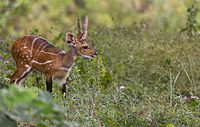

The Comoé National Park is the most biodiverse Savannah in the world and forms the northern limit for many animal species, like the Yellow-backed duiker and Bongo.[2] There are a total of 135 mammal species in the park.[1] This includes 11 species of primates like the olive baboon, green monkey, diana monkey, Mona monkey, lesser spot-nosed monkey, white collared mangabey, black and white colobus and chimpanzee. A total of 17 carnivore species like the lion, leopard, spotted hyena, giant pangolin, aardvark and rock hyrax. There are also 21 species of artiodactyl present in the park including bushpig, warthog, hippopotamus, bushbuck, sitatunga, buffalo, red-flanked duiker, waterbuck, kob, roan antelope and oribi.[10] Threatened mammal species include the african elephant, wild dogs and possibly one of the last large populations of chimpanzee left in the Ivory Coast.[5]
There are over 500 species of birds, of which roughly 20% are inter-african migratory birds and another 5% palearctic migratory birds. Some prominent bird species include the Denham's Bustard , the Yellow-casqued hornbill, the brown-cheeked hornbill, the hammerkop, black-winged stilt, various raptors, four of the six West African stork species and five of the six West African vulture species. The park also contains 36 out of the 38 of the iconic bird species found in Sudo-Guinean savannas.[2]
The Comoé river and its tributaries contain 60 different species of fish and allow for an unusually high diversity of amphibian species for a savannah habitat with 35 species. There are also a total of 71 reptile species, of which three are crocodiles: the dwarf crocodile (threatened), nile crocodile and slender-snouted crocodile.[1] The floodplains around the river create seasonal grasslands that are optimal feeding grounds for hippopotamus and migratory birds.[11]
Flora
[edit]
The property contains around 620 plant species, composed of 191 ligneous species (62 trees, 129 shrubs and vines) and 429 herbaceous species, including 104 grasses.[1] The park provides an outstanding example of an area of transitional habitat, from forest to savannah, with various plant associations typical of more southern regions. Gallery forests, open forests and riparian grasslands occur alongside all types of savannah, which occupy roughly 90% of the park.[10] The forest is composed of many leguminous trees. The gallery forests are dominated by Cynometra sp.; the patches of dense dry forest by Isoberlinia doka, Anogeissus leiocarpus, Cola cordifolia, Antiaris africana, nationally threatened Chlorophora excelsa, and the edible akee Blighia unijugata. The flood plains are dominated by Hyparrhenia rufa.[1][10]
Threatened species
[edit]The species listed below represent a small sample of iconic and/or IUCN Red Listed animals and plants found in the National Park.
- Brown-cheeked Hornbill (Bycanistes cylindricus)
- Yellow-casqued Hornbill (Ceratogymna elata)
- Roloway monkey (Cercopithecus diana rolowayi)
- African Elephant (Loxodonta africana africana)
- Denham's Bustard (Neotis denhami)
- African Dwarf Crocodile (Osteolaemus tetraspis)
- Common Chimpanzee (Pan troglodytes)
Extinct species
[edit]- Giraffe (Giraffa camelopardalis), unknown extinction date[12]
- Black Rhino (Diceros bicornis), 1950's[12]
- Giant eland (Taurotragus derbianus), unknown extinction date[12]
- Cheetah (Acinonyx jubatus), 1960-1970[12]
- Zebra duiker (Cephalophus zebra), 1980's[12]
- Bohor reedbuck (Redunca redunca), unknown extinction date[12]
- Wild dogs (Lycaon pictus), 1990's[12]
Comoé National Park Research station
[edit]- Main Article:Comoé National Park Research Station

The Comoé National Park Research Station, located in the park, was founded by Prof. Linsenmair in 1989/90 and has since then thrived through numerous partnerships to become one of the most modern field stations in Africa, with electricity, running water, internet and a large climatised laboratory.[7] Since the 90s over 100 scientists from more than 20 international research institutions used the research station, publishing over 200 papers in peer-reviewed international journals. Far more students participated in regular advanced field courses and the empirical data for more than 40 diploma, masters and Ph.D. theses have been collected in the surroundings of the station. The focus of the field based research is on the frontier fields of ecology, e.g. ecophysiology, behavioural, chemical and evolutionary ecology.[13]
Conservation status
[edit]The property was inscribed on the List of the World Heritage Sites in Danger in 2003 because of the potential impact of civil unrest; decrease in the populations of large mammals due to increased and uncontrolled poaching and the lack of efficient management mechanisms. The property is protected by various national laws. The main management challenges are combating poaching, agricultural pressures, grazing, insufficient management and access control. In order to reduce these problems, an efficient surveillance system throughout the property, and the establishment of participatory management with local communities are required to diminish the pressures and impacts associated with the management of areas located on the periphery of the property.[14][1] Stabilisation of the country's political situation after the end of the Second Ivorian Civil War has led the wildlife authority OIPR (Office Ivorien des Parcs et Reserves) to reestablish a presence in the Comoé National Park. OIPR applied to the Rapid Response Facility (RRF) for funding and was successful in being awarded a maximum grant of $30,000 to assess the status of poaching threat and to eliminate that threat through the reinforcement of the authority of OIPR in the Park.[15]
Gallery
[edit]-
Bushbuck foraging next to the comoé river
-
Comoé roan antelope during the dry season
-
Butterfly found during the rainy season
-
Savannah fire in the park
-
Male kob antelope
-
Foraging Green monkey in a gallery forest
References
[edit]- ^ a b c d e f g h i Konaté, Souleymane; Kampmann, Dorothea (2010). Biodiversity Atlas of West Africa, Volume III: Côte d'Ivoire. Abidjan & Frankfurt/Main: BIOTA. ISBN 978-3-9813933-2-3.
{{cite book}}:|access-date=requires|url=(help) - ^ a b c "Comoé National Park". UNESCO. Retrieved 4 August 2015. Cite error: The named reference "WHC" was defined multiple times with different content (see the help page).
- ^ a b Kronberg, FGU (September 1979). Gegenwärtiger Status der Comoé und Tai Nationalparks sowie des Azagny-Reservats und Vorschläge zu deren Erhaltung und Entwicklung zur Förderung des Tourismus. Eschborn: Deutsche Gesellschaft für Teschnische Zusammenarbeit (GTZ). pp. 12–13.
- ^ a b Cormier-Salem, Marie-Christine; Juhé-Beaulaton, Dominique; Boutrais, Jean; Roussel, Bernard (2005). Patrimoines naturels au Sud : territoires, identités et stratégies locales. Paris: IRD éditions. ISBN 2-7099-1560-X.
- ^ a b c Fischer, Frauke (2004). "Status of the Comoé National Park, Côte d'Ivoire, and the effects of war". Parks: War and Protected Areas. 14 (1): 17–25.
- ^ "Evaluation rapide de l'etat du parc national de la Comoé: les grands mammiferes et les activites illegales humaines". Wild Chimpanzee Foundation: 1–38. June 2008.
- ^ a b Habekuss, Fritz (2015). "Der Patron und sein Paradies". Die Zeit. No. N°11/2015. Retrieved 29 July 2015.
{{cite news}}:|issue=has extra text (help) - ^ "Comoé National Park, Côte d'Ivoire". Rapid Response Force. RRF. Retrieved 15 August 2015.
- ^ "Comoé National Park". IUCN. World Heritage Outlook. Retrieved 4 August 2015.
- ^ a b c McGinley, Mark. "Comoé National Park, Côte d'Ivoire". Encylopedia of Earth. United Nations Environment Programme-World Conservation. Retrieved 12 September 2015.
- ^ Mepham, Robert (1991). IUCN Directory of African Wetlands. Pinter Pub. Ltd. ISBN 2-88032-949-3.
- ^ a b c d e f g Fischer, F.; Gross, M.; Linsenmair, K. E. (2002). "Updated list of the larger mammals of the Comoé National Park, Ivory Coast". Mammalia. 66 (1): 83–92.
- ^ Linsenmair, Eduard. "Tropenforscher kehren zurück". University of Würzburg. einBLICK. Retrieved 29 July 2015.
- ^ Mauvais, Geoffroy; Youssouph, Diedhiou (24 June 2012). "In trouble and in need: West Africa's World Heritage". IUCN. Retrieved 4 August 2015.
- ^ "Wildlife authority of Côte d'Ivoire awarded Rapid Response Facility grant to combat poaching after period of civil unrest". UNESCO. Retrieved 4 August 2015.
External links
[edit]Category National parks of Ivory Coast Category World Heritage Sites in Ivory Coast Category Biosphere reserves of Ivory Coast Category Protected areas established in 1968



